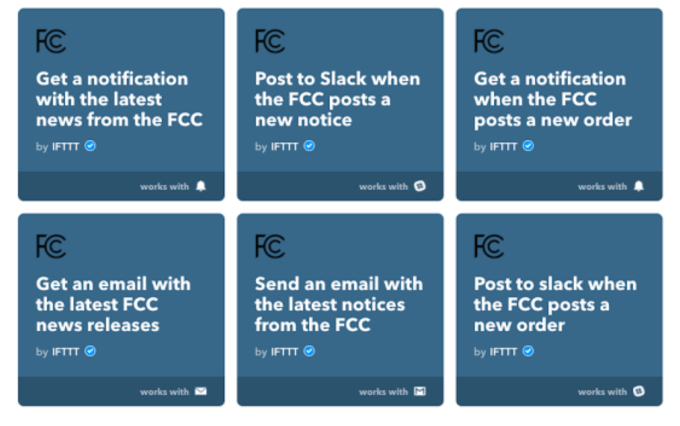
Today, all around cool internet thing IFTTT is hooking all kinds of useful public data into its powerful platform. With the launch of its new Data Access Project, IFTTT will add support for a broad selection of government agencies, organizations and research and cultural groups. That includes public data from federal and state government feeds on down to municipal transit information.
The new data streams have the potential to be all kinds of useful. In practice, that means every time there's a relevant new SEC filing, your Hue lights can flash green (or red, depending). Or you can get a text every time the State Department posts a travel warning. Or a Slack notification each time the Department of Defense posts an update. Or lots of things — infinitely configurable things, really.

Put simply, IFTTT lets you connect things to other things. It does this through easy to set up custom formulas, like "every time @techcrunch tweets, call my phone." These logic statements, all take the form of "if x happens, do y," hence the name If This Then That (IFTTT). IFTTT used to call these formulas Recipes but now they're calling them Applets, which is more confusing in our book but the functionality remains the same.

IFTTT's more than 40 new sources include:
- Department of Labor
- Bureau of Economic Analysis
- Federal Communications Commission
- Environmental Protection Agency
- Library of Congress
- National Science Foundation
- Energy Information Association
- USA.gov
- Pew Research Center
- Department of Defense
- Centers for Disease Control
- Amtrak
- Caltrain
- Texas Legislature
- Electronic Frontier Foundation
- American Civil Liberties Union
For IFTTT, the public data initiative stands to breathe some new life into a platform that in recent years is perhaps best known for letting you automate quirky things in your smart home. As a (really) long time IFTTT user, I have to say that it's an exciting and potentially very useful new direction. I fully expect to lose hours configuring my own public data streams in the coming days.
According to IFTTT CEO Linden Tibbets, the beauty of the service's new direction is that it can help users organize yet another kind of information that might otherwise be overwhelming and put it to good use.
"It's not that the information isn't out there — companies, governments, and institutions are releasing information all the time. But for the average person, it's overwhelming," said Tibbets.
"We've built out services whose data impacts people in very real ways: governments, agencies, non-profits, transits, and other institutions. Now people can easily find, and use, that information in brand new ways. We're excited to see the response, and plan to expand the Data Access Project with more services in the near future."
Apparently, this could be the tip of the iceberg for IFTTT's foray into helping people harness the power of public information that's already floating around.
"People are hungry for public data, especially when it comes to staying on top of the news and government," said Anne Mercogliano, IFTTT Vice President of Business Operations and Marketing. "Our IFTTT team kept seeing more and more amazing data resources out there and realized it was something we wanted to invest in and help build and bring onto the platform. We hope the Data Access Project is helpful for the average person, researcher, official and more."
Mercogliano notes that ProPublica's IFTTT channel saw a significant boost in interest after November 8, 2016. And in March of this year, IFTTT launched a collection of "Applets for activism" that sought to tap into that same phenomenon.
"Customizing your experience is at the heart of IFTTT and we want to ensure you're getting all of the data you need but in a way that works for your lifestyle," Mercogliano said. "The Data Access Project is an ongoing initiative for us and we're looking for any government, local agency or nonprofit to be a part of our project."
Interested groups can contact IFTTT at dap@ifttt.com to get started.